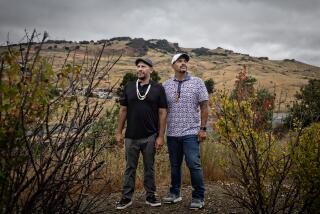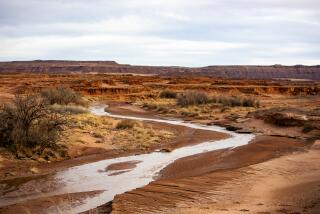Law Was Designed to End Tribes’ Dispute
- Share via
BIG MOUNTAIN, Ariz. — An agreement that was made federal law last year was designed to end the long-running land dispute between the Navajo and Hopi tribes.
But although most Navajo families on Hopi land have signed 75-year leases allowing them to stay, several contentious issues remain.
One of them is grazing, a topic that still stirs hard feelings on both sides. Earlier this year, a federal appeals court upheld a $21-million judgment against the Navajo Nation for overgrazing on Hopi land during the dispute.
Before the accommodation agreement, grazing permits with the Bureau of Indian Affairs allowed Navajo families on Hopi land about 4,900 sheep. The accommodation agreement calls for grazing permits of up to 11,200 sheep.
That breaks down to about 120 sheep per Navajo family.
“Navajo make a living off of livestock, and that’s not even close to enough to make a living,” said Betty Tso, a leader of the group of Navajo families who have signed the leases. “But that’s what was given, and that’s what we’re working with.”
The area has also suffered from drought for several years, and the Hopi tribe has imposed further restrictions on livestock on tribal land. The Navajo families could be forced to cull their herds along with Hopi ranchers, said Clayton Honyumptewa of the Hopi tribe’s land management office.
“It’s not good news for anybody. They just have to understand it’s everybody, not just Navajos. It’s Hopis also,” Honyumptewa says.
Navajo resisters like Pauline Whitesinger also accuse the Hopi of wanting to open the disputed area to mining, noting that the huge Black Mesa mine of Peabody Coal Co. straddles the northern border of the Hopi Partitioned Land.
The Hopi strenuously deny that charge; Honyumptewa noted that the Hopi tribe has banned mining since 1976 and a 1988 tribal land-use plan designates the Big Mountain area as a wildlife preserve. Peabody has rights to mine on a few thousand acres in the disputed area, but has no plans to do so in the foreseeable future, Honyumptewa said.
“They’re saying we want to get it so we can mine it, and that’s just not true,” Honyumptewa says. “The tribe has set aside the Big Mountain area as a wilderness area.”
Another sticking point is which tribe will provide and pay for services to the Navajo families on Hopi land. The Hopi have proposed having the Navajo Nation pay the Hopi tribe to provide services to the families, but Navajo officials have balked.
“The Navajo Nation is part of the problem, because they have resolutions in place not supporting the accommodation agreement, but they say it’s an individual choice whether to sign the leases,” Betty Tso says. “Technical assistance is not forthcoming.”
More to Read
Sign up for Essential California
The most important California stories and recommendations in your inbox every morning.
You may occasionally receive promotional content from the Los Angeles Times.










